Moving with all this teaware is hell.
Moving
July 29, 2009 · Leave a Comment
Categories: Misc · Objects · Old Xanga posts
Tagged: musings, teaware
Drinking tea with no leaves
July 27, 2009 · 9 Comments
I’ve voiced this before, but it happened again over the past weekend, and it really mystifies me.
Why do teahouses in the United States serve tea without giving you the leaves?
What I mean is, when you go to one of these establishments, you order your tea (in this case, Keemun). They take your order, and give you a pot with a cup. It’s an English style pot. Nothing’s wrong with that, except that there are no leaves in there — just pre-infused tea. I know this is probably not going to bother most people, and in fact, may even be great for most of the casual visitors to such establishments, but it annoys me, especially because these places often also promote themselves as serious teahouses.
Without seeing the leaves, I have no way of really controlling how the tea is brewed. Most of the time, the tea comes out weak, slightly understeeped, and most important of all, there is no chance for redemption — you cannot resteep the tea, you cannot add more hot water, and you have no way to look at the wet leaves, because they don’t give it to you. Perhaps I can ask for it, and perhaps they will entertain me, but I don’t think this should be necessary. The ability to resteep leaves multiple times is, in my opinion, a fundamental distinction between tea and coffee, and the nuances and changes that a tea undergoes from infusion to infusion is a great part of the enjoyment of any particular brew. Taking the leaves away deprives me of all that.
I can think of some reasons why a store may decide to do such things, for example
1) Shorten visits — if you can reinfuse tea, you are more likely to sit there for longer. Bad for business, obviously
2) Likewise, the possibility of reinfusing tea means you are less likely to order another pot, which of course means less money
3) Some people are clueless as to how to make tea, so doing it for them removes the possibility that they will screw it up, think it’s bad, and never come back again
While 3 is a legitimate concern (and I suppose 1 and 2 are too, for different reasons), I find it hard to swallow. A serious tea place, IMHO, should probably at least offer the choice of leaves or no leaves. A universal no leaves policy leaves something to be desired. Or at least, for me, that’s a rather disappointing thing to see in shops and teahouses. Maybe I’m being too much of a purist, but I still think that if I am buying tea to drink, I am buying the leaves, not the infused product — especially if I’m getting charged $4 for it.
Categories: Old Xanga posts
Tagged: musings, shopping, travel
Back at home…
July 23, 2009 · 3 Comments
Finally, after about two weeks, I’m back at home, drinking tea properly for the first time.
A few things I noticed on the trip
1) Tap water in places like Utah and Arizona are very high in mineral content. When I boil them, oftentimes there are precipitation. I have no idea what’s in the water, but since a lot of them come from aquifers, I guess this is no surprise.
2) Driving many hours in the car with the bag of aged oolong in my backpack under the scorching summer sun means that the tea suffered some heat damage — I can tell that by the end of the two weeks, the tea has at least changed somewhat. Detailed testing to follow to see if this is just placebo or if the change was real.
3) As long as you have tea that can easily be made in a paper cup and a proper way to heat water, you can enjoy some pretty decent tea without anything else. The most problematic issue all along is to secure hot water — it’s really hard to find it on the road, especially hot water that isn’t contaminated by coffee taste.
4) The Grand Canyon is very big
Categories: Old Xanga posts
Tagged: travel
New neighbour
July 8, 2009 · 1 Comment
We have a new neighbour who just moved in a week or two ago, and they’ve already had a few kids since then

On another note, I’ll be off for a bit going on a little family vacation. I’d imagine that when I come back in two weeks, these kids will have grown some feathers already.
Categories: Misc · Old Xanga posts
Tagged: musings
The Demon Revealing Mirror
June 30, 2009 · 12 Comments
The Demon Revealing Mirror is one of those somewhat mythical and fantastical items in Chinese lore that supposedly will show who (or what) is a demon and who is really a human. You just shine the mirror on the object, and you’ll get your answer.
A friend of mine in China who presses his own cakes has likened a good silver kettle to one of these mirrors, and I must say I agree. I’ve been experimenting with my kettle the past few days with different teas, and comparing to what I think of the teas using the tetsubin, and I think one thing is clear, and that is how different they taste with the two kettles.
The two teas I’ve tried recently are both 2006 Yiwu, one being a fall tea that this friend pressed, and another being the 2006 spring Douji Yiwu. When I drank them with the tetsubin, the fall Yiwu tastes a bit flat and boring — rather unremarkable, in fact. The Douji, on the other hand, was quite nice.
All changed, however, with the silver kettle. The fall tea was very fragrant and strong. The Douji, on the other hand, turned out a little bitter and rough.
What to make of this?
Well, I think the silver kettle does a good job of telling you what the tea is like and highlighting the fragrant notes, while tetsubins are often softening — they round out the rough edges of the teas, and adding to the body of the tea. In this case, I think that’s exactly what happened — the Douji was rounded out by the tetsubin so that the bitterness and the roughness were subdued, leading to a rather pleasant drink, while the fall tea gets a little more subdued. Since it has few low notes to speak of, it doesn’t get much benefit from the tetsubin.
I’d hesitate to say that the silver kettle is more honest — highlighting the fragrant notes is not any more honest than smoothing out rough edges — but it does present a very different side of the tea. Here are some spent leaves for you to look at.
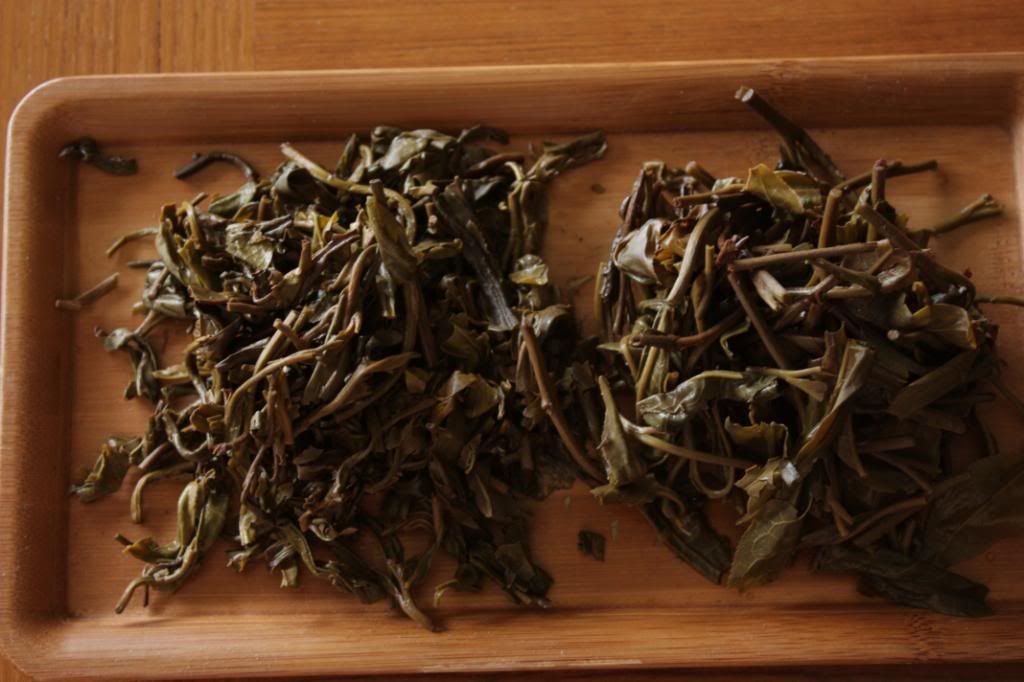
Categories: Objects · Old Xanga posts
Tagged: silver, teaware, tetsubin
Hand built or wheel thrown pot?
June 24, 2009 · 6 Comments
Here you go for the experts to peruse over.
I am still somewhat mystified by this particular pot, since it seems to have traits that I normally associate with hand built Yixing pots, but there are some things, like the outer surface and the spiral circles inside, that make me wonder….
Categories: Objects · Old Xanga posts
Tagged: teaware, yixing
Changing tastes
June 24, 2009 · 9 Comments
I rarely repeat the same tea two days in a row, and never with the same teaware. I think one of the joys of drinking tea is to thoroughly explore all the varieties that it offers, be it young, old, roasted, green, black. Add in the variety that you get with changing teaware, and the combinations are endless.
Weather was nice today after a nasty week of rain, so I decided to drink out on the balcony while my cats decide to soak up some sun. Rather than using my usual tetsubins, I opted for one of my silver kettles instead
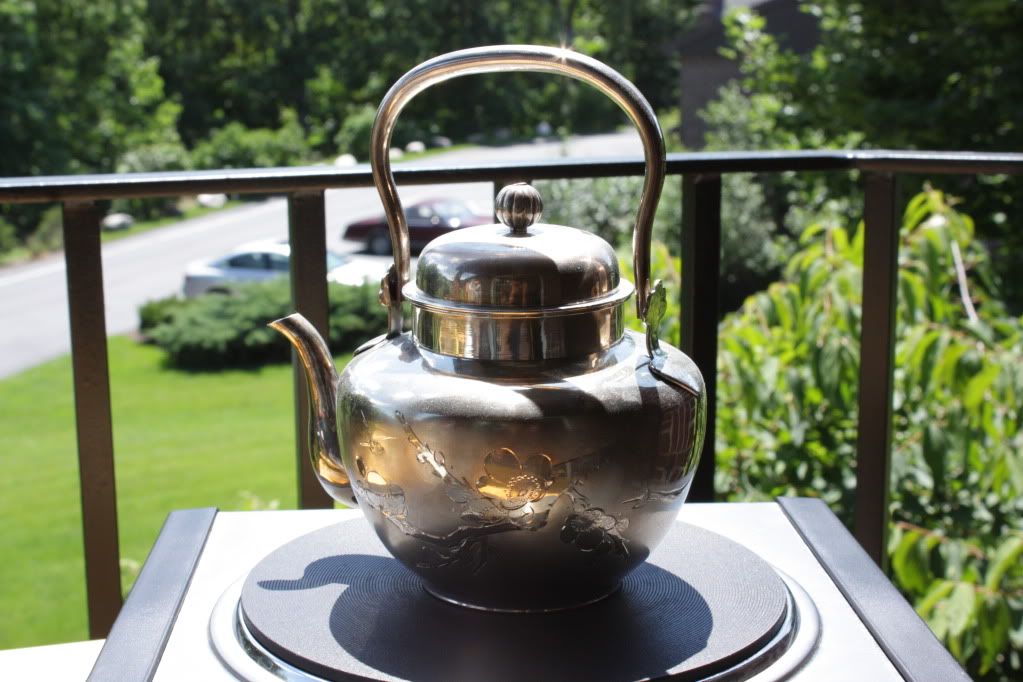

This is something I found on Ebay, of all places, for a rather reasonable price. It’s Korean in origin, and on one side is inscribed the words “For Mr. and Mrs. Henderson”. I’m pretty sure originally it was intended for use as a teapot, but it’s very large for a teapot, and I’d rather use it as a kettle, which is exactly what I did.
Water from silver kettles tend to accentuate the high notes in a tea. With good tea, the aroma will coat your mouth and linger for a long time. What it won’t do is to add to the body, and if the tea is sour, it may make that show up more prominently as well. So, whether it is really a good idea to use a silver kettle for the particular type of tea you’re drinking really depends. I don’t think silver kettles should be used universally for all teas. Tetsubins are much more versatile, I think.
The first tea I had today was an aged shuixian that I bought in Beijing almost three years ago.
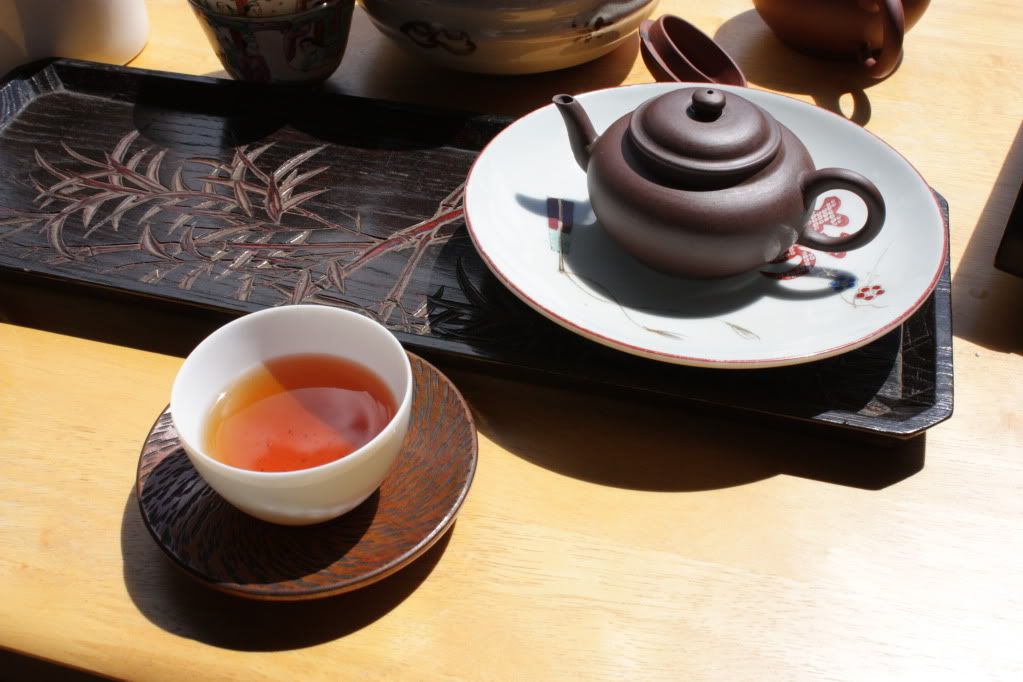
It tasted very different from the last time when I made it a few weeks ago, using my usual tetsubin. I think I actually prefer this tea with the tetsubin — the water from a tetsubin accentuates the qualitites of this tea. It’s not the highest grade of shuixian, just some common stuff, and perhaps it only deserves the commoner treatment.
The pot I used still baffles me though. For those of you familiar with bankoyaki, it might look awfully like one, and I still don’t know if this is actually a Yixing pot or not. Although the seal says “Yixing County Mengchan Made”, I have my doubts as to its geographical origin. Maybe the potters out there can tell me if this looks like a thrown pot or a hand built one.
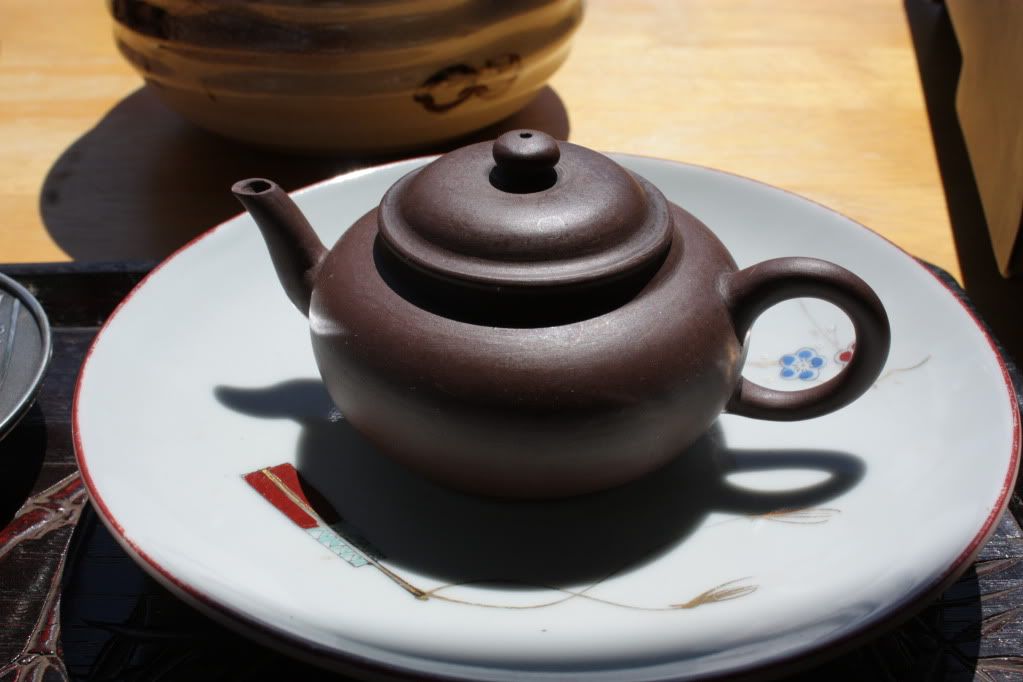



Not quite having enough tea, I had another, this time an aged oolong from Taiwan that I recently acquired. It’s nice and mellow, but works much better with the silver kettle. All in all, a pretty good day for tea.
Categories: Objects · Old Xanga posts
Tagged: aged oolong, silver, teaware, tetsubin, yixing
Bad tea, good tea
June 21, 2009 · Leave a Comment
I just came back from a short trip to Salem, MA, where a good friend got married. When you mention Salem, most people think witches, but in reality, witches was just a small part of the city, and the place’s claim to fame for much of its history was a center for the old China trade, where they imported porcelain of all types, and of course, tea. Salem is now home to the Peabody Essex Museum, which houses many artifacts from this once thriving trade route (if you’re nearby, you should visit), and where the wedding took place.
So it is with a little irony that it was last night, in this town, that I had perhaps the worst tea I have ever encountered. It’s in a bag form, of course
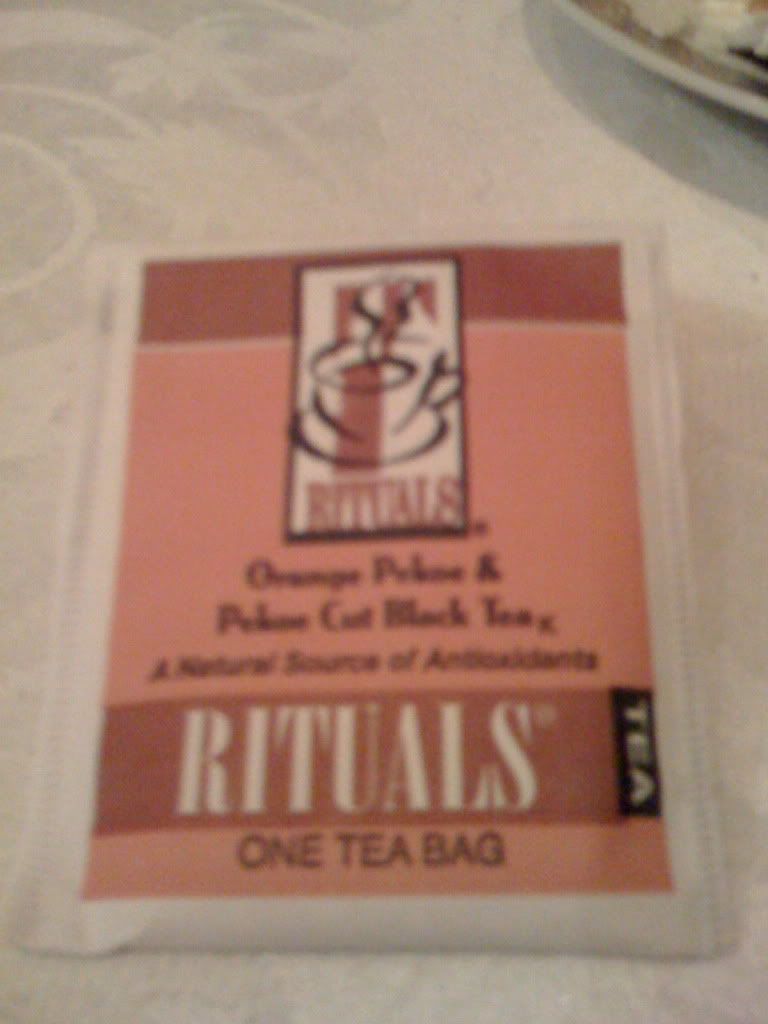
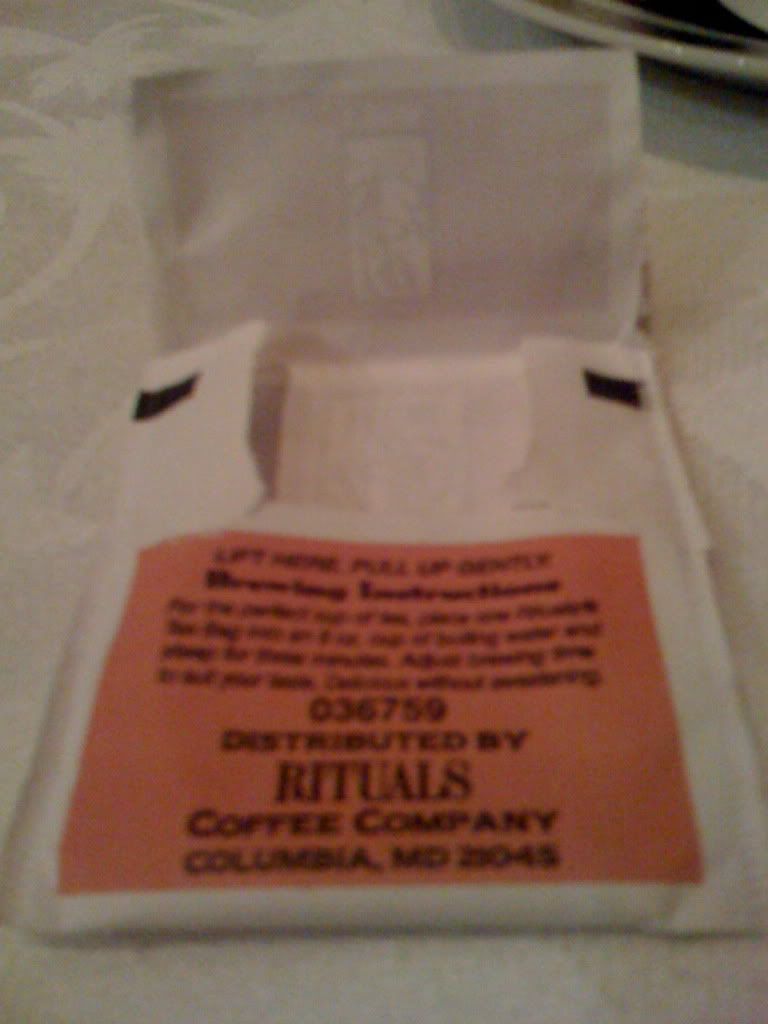
Sorry for the poor quality — taken with the phone. When you’re at somebody’s wedding, you can’t really say “no, please just give me a pot of hot water, as I brought my own tea”. You take what you’re given. I needed something to wash down the rather decent but rich wedding cake, so, heck, I’ll survive a tea bag.
Or so I thought.
The “Orange Pekoe & Pekoe Cut Black Tea” produced a “tea” that was rather acidic, more lemon juice like than tea, and utterly devoid of real tea flavour. Of course, it’s prepared by a coffee company — probably just a ploy to get people to stop drinking tea and instead, turn to the dark side of coffee. It was a very nice wedding, and the food was excellent. My wife said the coffee was all right as well. If only caterers can do better tea — it really ought not to be so hard, even when you’re trying to feed 150 people.
At least I should be pleased that it is a “Natural source of Antioxidants”. Now if only I drink this every day, I’ll live to a hundred years.
This morning we braved the horrific New England mid-June weather of rain and wind and went to downtown Salem to look at some things, hoping in vain that I might find some old China trade antique. The weather, however, was not cooperative, and we gave up quite quickly. This was not before we found a place called Jaho Coffee Roasters & Tea Merchants though. There were only a few customers, as I think the weather has deterred all but the bravest to go anywhere, but you can tell this is a place serious about its coffee. They also have a lot of tea canisters lined up along the wall, but as anybody who’s been to Teavana knows, that’s no guarantee of quality.
Turns out their tea selection, while certainly not like, say The Tea Gallery, was not terrible either. I ordered an Ali Shan oolong while my wife went for the more exotic coffees they have. I like to order oolongs at teashops I’ve never been to — it’s usually a pretty good indication of what their selection is like. If the oolong is awful, the place can’t be that good. If the oolong is decent, it’s probably all right. If the oolong is great, well, it’s promising. Everybody can do good black tea, and green tea is really too much of a hit or miss. Oolong is dependable… and less likely to be toxic waste.
The Ali Shan is what I expected it to be, light to medium fired, sweet, no hint of grass, which is good. The only problem I have is with the teaware
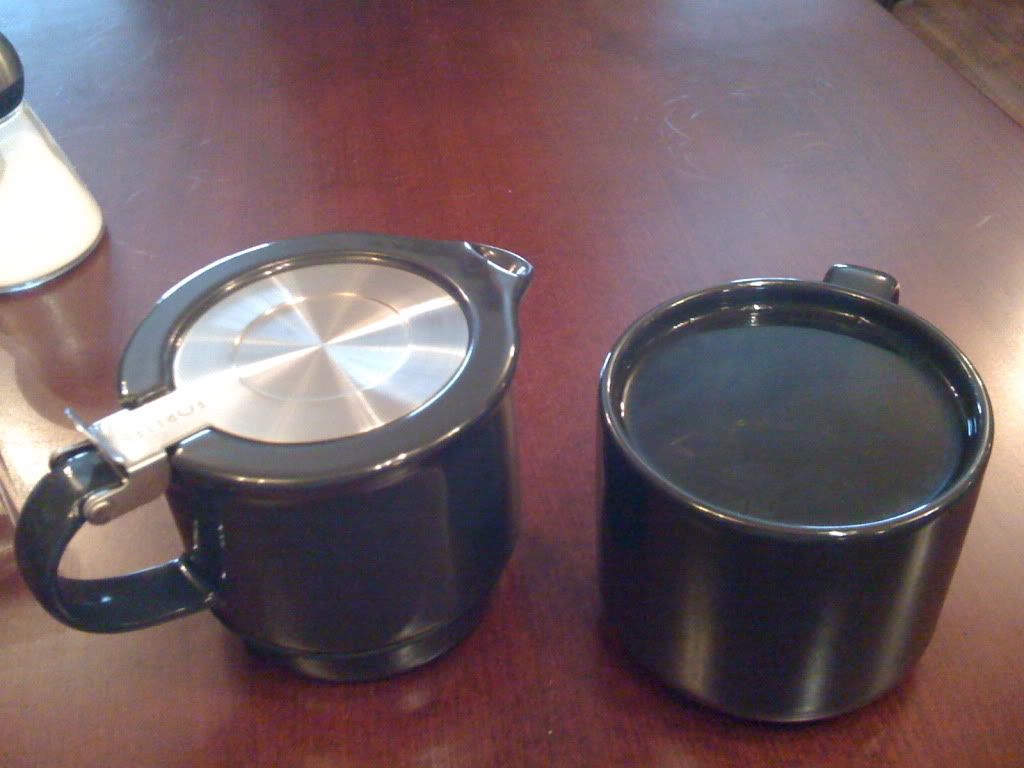
The same cup set as that other place I went to a few months ago. I’m sorry, but this kind of cup, while convenient for drinks service, really isn’t so good for tea drinkers. The problem is you simply cannot tell how well brewed your tea is, and there is absolutely no indication of the colour of the tea. I find that to be a very disconcerting thing, drinking a tea when I have no idea what colour the liquor is. One of the pleasures of tea is its varying colours, from a light shade of green when brewing a cup of longjing to a deep, dark cooked puerh, the range of the visual pleasure of seeing that colour is an experience in and of itself. Using a black cup completely obscures that aspect of tea. Why?
I suppose the tea timer I was given with the pot is a bit of a remedy, to try to tell the drinker how long he or she might want to steep the tea, but it’s still a poor substitute. I don’t think a coffee drinker would want to drink out of a cup that gives no indication of the colour of the brew, so why would a place that seems very serious about their coffee do that to tea?
Other than that though, no real complaints. My wife described the coffee there as mingblowingly good. I have no clue about coffee, so I won’t try to pass judgment. But I think if you’re in serious need of some tea when you’re in Salem, you can probably do a lot worse than going to Jaho.
Categories: Old Xanga posts
Tagged: Taiwan oolong, teabags, travel
Fussing about teaware
June 19, 2009 · 4 Comments
Pardon the ranting. Skip reading if you wish.
I keep seeing these topics posted on various forums about “is XYZ teaware safe to use?”, “does Yixing contain lead?”, and it’s really starting to bother me.
I understand we are all worried about the safety of our food, drink, and whatever else we put in our mouth. Everyone is rightly concerned about it. I also understand that with a new object that one has not dealt with before, it is entirely legitimate to ask these questions. However, inevitably there will be people who will say “yes, they do contain XYZ and you shouldn’t use it at all or you will suffer the consequences” or something along those lines. That’s what bothers me.
Let’s say we’re talking about yixing pots. Lots of people have asked in various places if they might contain nasty chemicals, lead, other heavy metals, dyes, etc that might be unsafe for consumption. That in itself is a very legitimate thing to ask. After all, you are drinking the tea, and since tea is mildly acidic it does make it more possible that some stuff might be leaching out of the pot, if there is anything there to begin with.
Then people will start suggesting that maybe you should try those lead test kits to see if the yixing pot has lead in it, or to only buy from reputable dealers, or to not buy low priced pots as they are likely to be bad for you, etc….
Let’s go through these one by one.
1) I’m not particularly sure exactly how effective each of these lead test kits work, but from the directions I’ve seen for testing ceramics or pottery, what you’re supposed to do is to soak the piece in vinegar, and then test the vinegar to see if any lead has leached out. Now, I’ve never tested the pH for tea, but I am pretty sure whatever it is, it is a lot higher (i.e. not nearly as acidic) as vinegar. I suppose you can do the same as use tea to soak the piece and then test the tea, but even then, the only way to really simulate drinking tea is to test the tea you’re going to drink yourself. I’d venture to guess that lead leaching is undetectable with any of these test kits in almost all cases. I’ve always suggested people to try this with black raku ware, which is known to have lead, as a control. So far, I still don’t know anybody who has responded to that when they say “oh my, these things will kill you with lead poisoning!”
2) As for reputable dealers – I am 100% sure that none of the people who sell pots online or offline have bothered to test the pots for lead in the method prescribed above. I remember a certain tea vendor who sells through his blog “testing” some of his yixing pots with these test kits, but only by rubbing the kit on the surface of the pot. That’s not how you do it, and whatever negative result is moot. So, reputable dealer really have no idea what’s in their pot if you are talking potentially harmful chemicals. If you don’t believe me, try asking. The usual answer you’d get is probably “I only source my pots from trusted sources”, which basically means “trust me”.
3) Lower priced pots are indeed more likely to be made with fake yixing clay, have shoe polish on them, etc, but as I’ve always said, a high priced item is not guaranteed to be good at all. You can have a fake yixing pot made with bad and harmful clay that is selling for $1000. Do not judge items on the price they’re selling for. It makes no sense to assume that price alone has anything to do with anything other than a merchant’s profit margin.
The point of all this is not that you should not buy anything. Rather, the point I’m trying to make is that most likely there is simply no good reason to worry at all. The harmful combination of 30g of fat on 120g of sugar in that piece of cheesecake you just ate is probably far worse than whatever trace amount of lead you got in the tea. Or, for that matter, the old lead pipes in your apartment building in New York city that still haven’t been changed. Or…. the list goes on.
If you think what you’re using is not safe, then stop using it. If you think it’s fine, then don’t worry about it. Worrying about a bowl or a pot that had tea in it for a few minutes at most is really not a good way to spend your time. And those people who keep harping on how China seems to be the only country that produces unsafe goods (nevermind that most goods, safe or unsafe, all seem to be produced in China these days) should just keep their fear-mongering to themselves.
Thanks for listening to my ranting.
Categories: Objects · Old Xanga posts
Tagged: shopping, teaware, yixing
Quick review: The True History of Tea
June 17, 2009 · 10 Comments
I don’t normally do book reviews, and I know that Corax of Chadao will be doing a much more thorough and thoughtful review of this book at some point or another, so here are just my quick thoughts on this nice, new, shiny book.
The book is by Victor Mair and Erhling Hoh. I know nothing about Erling Hoh. Victor Mair I do know by reputation — he’s a professor of Chinese language and literature at UPenn, and is very prolific with both scholarly work on philology, literature, and also translations of classical texts.
The pedigree of the author matters, because I feel that the authors of many of the books currently on the market that talk about tea, especially ones that purport to discuss the history of tea, are not familiar with the country they’re discussing, nor well versed enough in the language to use primary sources that are reliable. While this may be all right for a book that only makes gestures towards explaining the history of tea in East Asia, they inevitably have to rely on second hand evidence or anecdotes from other sources. They also tend to over-rely on Lu Yu’s Chajing because it along among older texts on tea is translated, giving it a place that is well deserved but not entirely representative.
This book does indeed try to fill that very large hole, not only in talking about the history of tea pre-Lu Yu, but also that of the period that came after but before the Europeans arrived to bring tea to their own shores. The authors really do try to cover the entire history of tea, from inception in China, its spread to Japan, the Islamic world, and then to Europe and the New World. They do so with a better command of the sources and materials than I’ve seen in other works on the same subject, and organized into a logical and easy to follow sequence. Great stuff for a quick, fun read, but also well suited for the course I’ll be teaching next semester on the history of tea. I’m ordering this for a textbook.
There are some glaring holes, however. There’s virtually no mention of Korea anywhere in this, and I think it’s always easy to forget that much of China’s cultural influences on Japan passed through Korea at one point or another. I’m sure tea is no exception, although that part of the story is really quite murky as far as I know. The other is that as someone who works on later imperial China, the history of tea in the last six hundred years of imperial rule was dealt with rather quickly in the space of one chapter. I know the story is richer than that, and I do think there’s room for more, not least becuase what happened in those years had a direct impact on what we’re drinking now. Maybe that’s for another work.
But either way — I’d highly recommend this book.
Categories: Old Xanga posts
Tagged: books, history


 RSS - Posts
RSS - Posts
Interesting.... would 250C in my oven work?